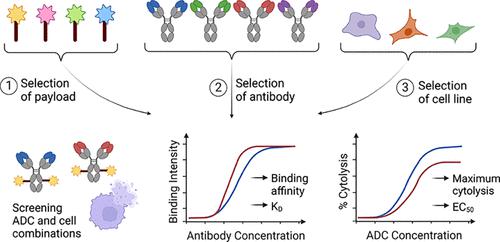当前位置:
X-MOL 学术
›
Bioconjugate Chem.
›
论文详情
Our official English website, www.x-mol.net, welcomes your feedback! (Note: you will need to create a separate account there.)
Exploring the Sensitivity of Antibody–Drug Conjugate Efficacy to the Selection of Payload, Antibody, and Cell line
Bioconjugate Chemistry ( IF 4.7 ) Pub Date : 2024-01-03 , DOI: 10.1021/acs.bioconjchem.3c00537 Mara Rao 1 , Shruthi Murali 2 , Danielle Amores 3 , Feifan Yu 3 , Andrew Tsourkas 2
Bioconjugate Chemistry ( IF 4.7 ) Pub Date : 2024-01-03 , DOI: 10.1021/acs.bioconjchem.3c00537 Mara Rao 1 , Shruthi Murali 2 , Danielle Amores 3 , Feifan Yu 3 , Andrew Tsourkas 2
Affiliation

|
Antibody–drug conjugates (ADCs) make up a growing class of targeted therapeutics with important applications in cancer treatment. ADCs are highly modular in nature and thus can be engineered to target any cancer type, but their efficacy is strongly influenced by the specific choice of payload, antibody, and target cell. Considering the number of possible antibody–payload combinations, ADC development would benefit from an efficient method to narrow the number of ADC compositions to those with the highest and most universal potency prior to assessing pharmacokinetics and pharmacodynamics in animal models. To facilitate the identification of optimal ADC compositions, we describe the use of photoreactive antibody-binding domain-drug conjugates (known commercially as oYo-Link) to enable the site-specific labeling of off-the-shelf antibodies. This approach allows for the rapid generation of ADCs with a drug-to-antibody ratio of ∼2 with no subsequent purification required. As a demonstration of this approach, ADCs were generated with different combinations of tubulin-inhibitor drugs (DM1, DM4, VcMMAE, and VcMMAF) and anti-EGFR antibodies (cetuximab, panitumumab, anti-EGFR clone 425, and anti-EGFR clone 528) and were delivered to three EGFR-expressing cell lines (A431, A549, and MDA-MB-231). Real-time cytolysis assays indicated that the most effective antibody varied based on the choice of cell line: cetuximab was most potent against A431 cells, while 425 and 528 led to the greatest cytotoxicity against A549 and MDA-MB-231 cells. These results did not correlate with differences in measured anti-EGFR binding affinity as cetuximab had the highest affinity across all three cell lines, while 425 and 528 had the lowest affinities for all three cell lines. Panitumumab, which had the second-highest anti-EGFR affinity, exhibited the least effective cytolysis across A431, A549, and MDA-MB-231 cells. By demonstrating that ADC potency toward a given target is dependent on both the antibody and drug chosen, these findings can guide the selection of ADCs for further in vivo analysis.
中文翻译:

探索抗体-药物偶联物功效对有效负载、抗体和细胞系选择的敏感性
抗体药物偶联物 (ADC) 构成了越来越多的靶向治疗药物,在癌症治疗中具有重要应用。ADC 本质上是高度模块化的,因此可以针对任何癌症类型进行设计,但其功效很大程度上受到有效负载、抗体和靶细胞的具体选择的影响。考虑到可能的抗体-有效负载组合的数量,ADC 的开发将受益于一种有效的方法,在评估动物模型中的药代动力学和药效学之前,将 ADC 组合物的数量缩小到具有最高和最通用效力的组合物。为了促进最佳 ADC 组合物的识别,我们描述了使用光反应性抗体结合域药物缀合物(商业上称为 oYo-Link)来实现现成抗体的位点特异性标记。这种方法可以快速生成药物与抗体比率约为 2 的 ADC,且无需后续纯化。作为该方法的演示,使用微管蛋白抑制剂药物(DM1、DM4、VcMMAE 和 VcMMAF)和抗 EGFR 抗体(西妥昔单抗、帕尼单抗、抗 EGFR 克隆 425 和抗 EGFR 克隆 528)的不同组合生成了 ADC )并被递送至三种表达 EGFR 的细胞系(A431、A549 和 MDA-MB-231)。实时细胞溶解测定表明,最有效的抗体根据细胞系的选择而变化:西妥昔单抗对 A431 细胞最有效,而 425 和 528 对 A549 和 MDA-MB-231 细胞具有最大的细胞毒性。这些结果与测量的抗 EGFR 结合亲和力的差异无关,因为西妥昔单抗在所有三种细胞系中具有最高的亲和力,而 425 和 528 对所有三种细胞系具有最低的亲和力。帕尼单抗具有第二高的抗 EGFR 亲和力,但在 A431、A549 和 MDA-MB-231 细胞中表现出最不有效的细胞溶解作用。通过证明 ADC 对给定靶点的效力取决于所选择的抗体和药物,这些发现可以指导选择 ADC 进行进一步的体内分析。
更新日期:2024-01-03
中文翻译:

探索抗体-药物偶联物功效对有效负载、抗体和细胞系选择的敏感性
抗体药物偶联物 (ADC) 构成了越来越多的靶向治疗药物,在癌症治疗中具有重要应用。ADC 本质上是高度模块化的,因此可以针对任何癌症类型进行设计,但其功效很大程度上受到有效负载、抗体和靶细胞的具体选择的影响。考虑到可能的抗体-有效负载组合的数量,ADC 的开发将受益于一种有效的方法,在评估动物模型中的药代动力学和药效学之前,将 ADC 组合物的数量缩小到具有最高和最通用效力的组合物。为了促进最佳 ADC 组合物的识别,我们描述了使用光反应性抗体结合域药物缀合物(商业上称为 oYo-Link)来实现现成抗体的位点特异性标记。这种方法可以快速生成药物与抗体比率约为 2 的 ADC,且无需后续纯化。作为该方法的演示,使用微管蛋白抑制剂药物(DM1、DM4、VcMMAE 和 VcMMAF)和抗 EGFR 抗体(西妥昔单抗、帕尼单抗、抗 EGFR 克隆 425 和抗 EGFR 克隆 528)的不同组合生成了 ADC )并被递送至三种表达 EGFR 的细胞系(A431、A549 和 MDA-MB-231)。实时细胞溶解测定表明,最有效的抗体根据细胞系的选择而变化:西妥昔单抗对 A431 细胞最有效,而 425 和 528 对 A549 和 MDA-MB-231 细胞具有最大的细胞毒性。这些结果与测量的抗 EGFR 结合亲和力的差异无关,因为西妥昔单抗在所有三种细胞系中具有最高的亲和力,而 425 和 528 对所有三种细胞系具有最低的亲和力。帕尼单抗具有第二高的抗 EGFR 亲和力,但在 A431、A549 和 MDA-MB-231 细胞中表现出最不有效的细胞溶解作用。通过证明 ADC 对给定靶点的效力取决于所选择的抗体和药物,这些发现可以指导选择 ADC 进行进一步的体内分析。



























 京公网安备 11010802027423号
京公网安备 11010802027423号